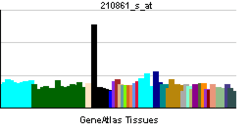WNT1-inducible-signaling pathway protein 3
| WISP3 | |||||||||||||||||
|---|---|---|---|---|---|---|---|---|---|---|---|---|---|---|---|---|---|
| Identifiers | |||||||||||||||||
| Aliases | WISP3, CCN6, LIBC, PPAC, PPD, WISP-3, WNT1 inducible signaling pathway protein 3 | ||||||||||||||||
| External IDs | MGI: 2685581 HomoloGene: 77038 GeneCards: WISP3 | ||||||||||||||||
| |||||||||||||||||
| RNA expression pattern | |||||||||||||||||
 | |||||||||||||||||
| More reference expression data | |||||||||||||||||
| Orthologs | |||||||||||||||||
| Species | Human | Mouse | |||||||||||||||
| Entrez | |||||||||||||||||
| Ensembl | |||||||||||||||||
| UniProt | |||||||||||||||||
| RefSeq (mRNA) | |||||||||||||||||
| RefSeq (protein) | |||||||||||||||||
| Location (UCSC) | Chr 6: 112.05 – 112.07 Mb | Chr 10: 39.15 – 39.16 Mb | |||||||||||||||
| PubMed search | [1] | [2] | |||||||||||||||
| Wikidata | |||||||||||||||||
| View/Edit Human | View/Edit Mouse |
WNT1-inducible-signaling pathway protein 3[3][4] (WISP3, also named CCN6) is a matricellular protein that in humans is encoded by the WISP3 gene.
Structure
It is a member of the CCN family (CCN intercellular signaling protein) of secreted, extracellular matrix (ECM)-associated signaling matricellular proteins. The CCN acronym is derived from the first three members of the family identified, namely CYR61 (cysteine-rich angiogenic inducer 61, or CCN1), CTGF (connective tissue growth factor, or CCN2), and NOV (nephroblastoma overexpressed, or CCN3). These proteins, together with WISP1 (CCN4), and WISP2 (CCN5) comprise the six-member CCN family in vertebrates. CCN proteins characteristically contain an N-terminal secretory signal peptide followed by four structurally distinct domains with homologies to insulin-like growth factor binding protein (IGFBP), von Willebrand type C repeats (vWC), thrombospondin type 1 repeat (TSR), and a cysteine knot motif within the C-terminal (CT) domain.
Function
The CCN family of proteins regulates diverse cellular functions, including cell adhesion, migration, proliferation, survival, and differentiation.[5][6][7]
Clinical significance
Mutations in the human WISP3 gene are associated with progressive pseudorheumatoid dysplasia, a juvenile onset autosomal recessive skeletal disorder, indicating that the gene is essential for normal postnatal skeletal growth and cartilage homeostasis.[8] However, mice with WISP3 knockout or overexpression are normal and suffer no apparent developmental defect.[9][10] Loss of WISP3 expression is associated with aggressive inflammatory breast cancer and breast cancer with axillary lymph node metastasis, suggesting that WISP3/CCN6 may function as a suppressor of breast cancer growth and metastasis.[4]
References
- ↑ "Human PubMed Reference:".
- ↑ "Mouse PubMed Reference:".
- ↑ Jun JI, Lau LF (December 2011). "Taking aim at the extracellular matrix: CCN proteins as emerging therapeutic targets". Nat Rev Drug Discov. 10 (12): 945–63. doi:10.1038/nrd3599. PMID 22129992.
- 1 2 Huang W, Pal A, Kleer CG (March 2012). "On how CCN6 suppresses breast cancer growth and invasion". J Cell Commun Signal. 6 (1): 5–10. doi:10.1007/s12079-011-0148-9. PMC 3271195
 . PMID 21842227.
. PMID 21842227. - ↑ Chen CC, Lau LF (April 2009). "Functions and mechanisms of action of CCN matricellular proteins". Int. J. Biochem. Cell Biol. 41 (4): 771–83. doi:10.1016/j.biocel.2008.07.025. PMC 2668982
 . PMID 18775791.
. PMID 18775791. - ↑ Holbourn KP, Acharya KR, Perbal B (October 2008). "The CCN family of proteins: structure-function relationships". Trends Biochem. Sci. 33 (10): 461–73. doi:10.1016/j.tibs.2008.07.006. PMC 2683937
 . PMID 18789696.
. PMID 18789696. - ↑ Leask A, Abraham DJ (December 2006). "All in the CCN family: essential matricellular signaling modulators emerge from the bunker". J. Cell. Sci. 119 (Pt 23): 4803–10. doi:10.1242/jcs.03270. PMID 17130294.
- ↑ Hurvitz JR, Suwairi WM, Van Hul W, El-Shanti H, Superti-Furga A, Roudier J, Holderbaum D, Pauli RM, Herd JK, Van Hul EV, Rezai-Delui H, Legius E, Le Merrer M, Al-Alami J, Bahabri SA, Warman ML (September 1999). "Mutations in the CCN gene family member WISP3 cause progressive pseudorheumatoid dysplasia". Nat. Genet. 23 (1): 94–8. doi:10.1038/12699. PMID 10471507.
- ↑ Kutz WE, Gong Y, Warman ML (January 2005). "WISP3, the gene responsible for the human skeletal disease progressive pseudorheumatoid dysplasia, is not essential for skeletal function in mice". Mol. Cell. Biol. 25 (1): 414–21. doi:10.1128/MCB.25.1.414-421.2005. PMC 538768
 . PMID 15601861.
. PMID 15601861. - ↑ Nakamura Y, Cui Y, Fernando C, Kutz WE, Warman ML (June 2009). "Normal growth and development in mice over-expressing the CCN family member WISP3". J Cell Commun Signal. 3 (2): 105–13. doi:10.1007/s12079-009-0040-z. PMC 2721080
 . PMID 19401829.
. PMID 19401829.